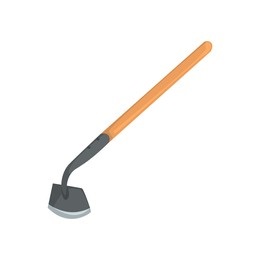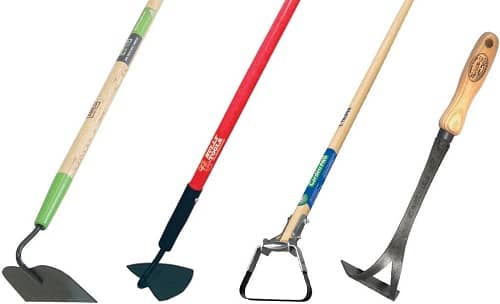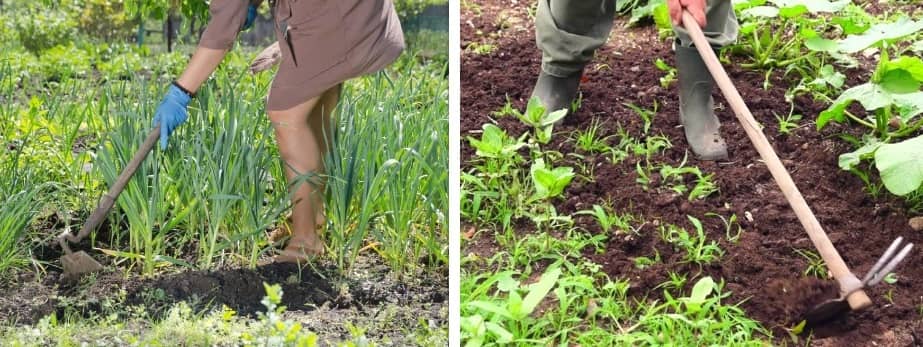Do you know how to use a garden hoe in the most effective ways? In the case of hoeing the garden & remove lawn weeds. Every homeowner desires a beautiful-looking lawn. A beautiful lawn is a symbol of passions and aesthetics works. It needs to take care of your lawn every single period or a combination of times to make an elegant lawn. Hoeing is one of the most important tasks to perform for every lawnmower, and it needs to hoe when the lawn is almost full of weeds, and there is a chance to cover the whole lawn.
There are many ways to hoe your lawn, but the most important thing you have to know how to use a hoe and which methods best suit you and your lawn. Different homeowners have different ideas to hoe, but you have to choose the right garden hoe, options, and designs to perform your job.
Hoeing the Garden & Remove Lawn Weeds

Why you should use a hoe? Using a garden hoe is very important to control weeds from your lawn. It allows you to pull the weeds while standing up, thus saving your time and cleaning a larger area in the short term. Once weeds have gotten very large, or if your soil is compacted or dry, you need to take care of your lawn by using a garden hoe.
When you use a garden hoe in your lawn frequently, it allows you to save your energy later, avoiding struggling with large weeds. It also saves you much more time from your busy life as we know time is money. So, it is essential to run a hoe on your lawn regularly.
But at the very beginning of starting your hoeing works, you have to know different types of hoes and the best ways to apply them to the lawn in your circumstance.
Types of hoe:

Fortunately, there are so many types of garden hoes. Also, you can find that different types of designs are available. It is a traditional type of tool made up of a handle and a metal blade attached to the bottom of the handle. Different types of hoes largely depend on the shape, size, and angle of blades and the proper task to perform, but all the hoes effectively control weeds in your lawn.
- Draw hoes: It is also known as paddle or chopping hoes, and it has a rectangular blade. The blade remains perpendicular to the handle, and it can be drawn in one direction towards you. It is very handy to do your job smoothly, chopping down and pulverizing compacted soil very easily.
- Triangular hoes: It is also known as dutch hoes or warren hoes or riding hoes, and it has a blade attached in a triangular or heart-shaped handle. It is also used to draw in one direction, especially to make furrows for seedlings.
- Scuffle hoes: It is also known as stirrup hoes, and it has a smaller angle between the blades and handle than the other classic hoes. It is effortless to handle. It has both push and pull-behind type facilities, which make your work convenient and run over the top layer of soil very quickly. It is also designed with a loop, ring or stirrup on a horse saddle. Though it removes the weeds in both directions, so the whole process becomes speedy.
- Onion hoes: This is a wider version of the draw hoe’s head, and both ends are very sharp. It comes with a short handle for working close to the ground.
All types of hoes are effective in controlling weeds from your lawn. Still, scuffle types are more convenient than others as they can be used in both directions and have a high cutting ability.
Selecting the best garden hoe:
You don’t feel the same comfort for all hoes because one size doesn’t fit all. The shape and size of a garden hoe largely depend on your body so that you can work comfortably with your full efforts. Suppose you have any backache when you bend over into an unknown position. In that case, you can’t work for a long time, also sometimes, it may be troublesome to grip the handle. So, you have to notice the proper length as well as the handle of your hoes.
- Proper Length: When you perform your job, you have to stand up straight, so the right length which suits best for you is essential. You have to choose a hoe which is long enough to do your job in a straight position to avoid backache. Most homeowners prefer lengths from 54 to 60 inches so that the tip should come close to the upper chest. You can also purchase a 68-inch dutch hoe if you prefer a more extended handle; this hoe has a special added feature of teeth that helps you pull up stubborn weeds when you need to get rid of them immediately.
- Perfect Handle: You can choose different types of handles such as wooden or bamboo or some metal handle. Wooden handles are very soft and more comfortable to hold, but it makes your tool much heavier. On the other hand, Aluminium handles are very light. Still, you have to ensure that the handle is rubberized correctly in the proper position; otherwise, there will be a problem gripping the tools; another problem you may face is that it is very uncomfortable to grab when you are in cold weather use a metal handle.
- For young weeds: If you need to control the young weeds popping up in your lawn in a large area or amongst your row of plants, you have to try a lightweight scuffle hoe. A diamond, triangle, or stirrup hoe will work best on young weeds.
- For large weeds: If your lawn is full of large weeds and you need to deal with these large weeds, you can use various hoes to get rid of these weeds. You can try with grub or field hoe. Also, you can use a warren hoe or a standard American harden hoe. These hoes are also effective for making furrows and chops compost.
- For tight space: You are recommended to use a short handle hoe if you are working in a tight space or you need to remove spot weeding. You can also use a circular hoe, collinear hoe, or other hoes set on a short handle.
- Time of Hoeing: Hoeing time is crucial for your lawn, and spring is the best time to perform this job when it is time to start germinating the annual weeds. One of the most important tasks to manage flower beds, vegetable gardens, or lawns is to hoe weeds at first sight. It is more difficult to hoe when your lawn weeds cover your whole yard. So, you have to wait until you see that the weeds emerge, and it will take over your yard a few days later if you don’t control them immediately.
- You have to hoe when your lawn soil is much drier as far as possible to allow dust mulch to inhibit weeds from emerging. You should follow hoeing in the early morning before watering your lawn.
How to use a garden hoe properly in 8 ways?

The most useful thing about using a garden hoe is it allows you to proactively control the weeds over a large patch of ground. Also, it allows you to control weeds between rows in your vegetable garden. You can do your job easier when your land is soft but not wet, and the hoe can be used in bare areas or mulches. The most effective ways of hoeing weeds are stated below-
- Standing up straight: Before starting, stand up in a straight position as far as possible, pick up the handle of the hoe and stand it on the ground and stretch it away from you. Always place it down so that the blade sits just below the soil’s surface in the area to weed, and notice that you are in as upright a position as possible when hoeing your law to make your job easier and comfortable.
- Dig very lightly: You have to dig the soil very lightly and follow the push and pull motion as if you are cleaning the floor. This will allow you to sever the weeds rotted under the ground, and it needs your fewer efforts.
- Do your job on warm-dry days: You should have done your hoeing job on warm-dry days so that the weeds become wither and dry very shortly. Also, it allows you to get a good mulch of weeds by decomposing them very quickly.
- Always follow a sweeping motion: You have to grab the hoe and make sweeping motions over the top of the weeds to slice the top weeds.
- Cut the weed stem: You have to cut the weed stem and aim to sweep your hoe just below the soil surface to cut off the top of the weeds at this level to control the further growth of weeds.
- Follow precise and cautious while hoeing: It is vital to follow precise works. You have to be cautious while hoeing weeds to arrive at the aim for your accuracy. Any kind of lousy sweeping can damage your desired plants badly, like flowers, fruits or vegetables. You have to make sure that your hoe passes easily and precisely between the rows of the chosen plants.
- Frequently change your hands: Hoeing weed is not an easy task, it needs hard labor, and sometimes it can cause hands, arms, or backaches. So, you have to try to distribute the labor on both sides of your body to avoid some aches, and you can do this by switching hands and arms frequently. You can wear hand gloves to protect your hands while hoeing.
- Use a rake: After completing your hoeing job, you have to use a rake to gather all the weeds just released from the soil. Also, you can do it by keeping them for a few days to dry completely and then compile them to your compost pile or let them to your lawn which doesn’t harm your lawn. Moreover, it can turn into an excellent natural mulch and adds beneficial organic matter to your soil.
Maintenance of your garden hoe:
If you need to take care of your lawn by using a garden hoe, it is also essential for you to take care of your hoe or you need to follow proper maintenance of hoe for hoeing work. A garden hoe is designed to slice weeds in back and forth motion, so your job will be much easier if you use a sharp blade. You can sharpen your hoe as well as other household tools in your local hardware store. You need to sharpen your tools after a certain period when you notice that your tools become dull.
Final Thoughts:
Hoeing is a speedy and essential task for your lawn. When your land becomes compact or full of stubborn weeds, it is needed to hoe as soon as possible. Different homeowners have different ideas to hoe according to their situations. Still, we already mentioned that scuffle-type hoe is best for all. It is convenient for everyone as it has special push and pull features from a standing position and removes weeds from both directions. Go early in the morning for hoe before watering when the soil remains dry so you can move the hoe quickly.



